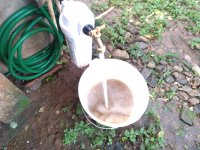I use city water, which is sourced from surface water and heavy rains can load it with a lot of sediment. Right now it has so much sediment that washing clothes gets them dirtier, as I inadvertently discovered to my wife's annoyance (thanks for nothing, Hurricane Eta). So I installed an inline filter upstream from the washing machine with a pleated 50 micron filter. Seeing no improvement, I tried 5 micron and 1 micron polypropylene filters. Still no improvement. I'm stumped, because all online resources I have found say that this is the range of filters that should work for different kinds of sediment.
What does reduce the level of sediment, although not enough for my purpose, is to reduce the flow rate. If I mostly close the shutoff valve just upstream from the filter so that only a trickle comes out, the water is less muddy. It is still too dirty to to wash clothes with, and the pressure is too low for the washing machine to use, but it is a data point.
Ideally I would call in a professional at this point, or at least get the water tested to determine the diameter and composition of the sediment, but those are not options here. I'm in a small town in a developing country and will have to make do myself with what I can find in the hardware store.
What might I be doing wrong, and what might I try to get water clean enough for the washing machine?
What does reduce the level of sediment, although not enough for my purpose, is to reduce the flow rate. If I mostly close the shutoff valve just upstream from the filter so that only a trickle comes out, the water is less muddy. It is still too dirty to to wash clothes with, and the pressure is too low for the washing machine to use, but it is a data point.
Ideally I would call in a professional at this point, or at least get the water tested to determine the diameter and composition of the sediment, but those are not options here. I'm in a small town in a developing country and will have to make do myself with what I can find in the hardware store.
What might I be doing wrong, and what might I try to get water clean enough for the washing machine?

